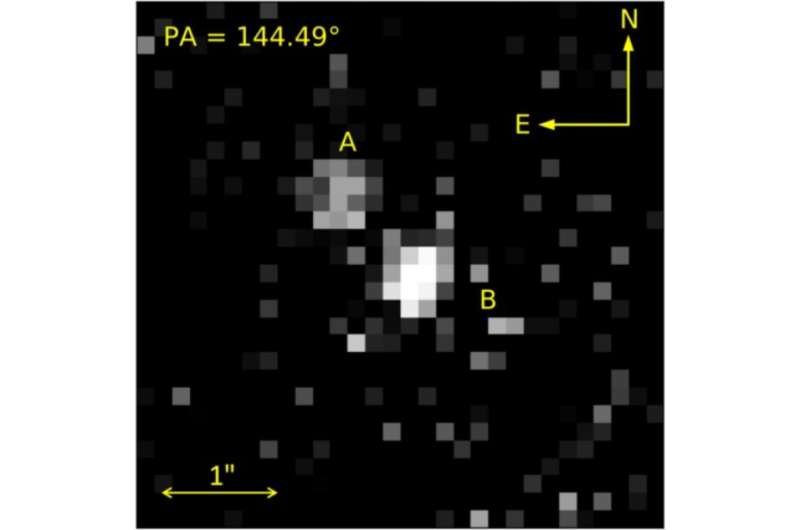 GNIRS H-band acquisition image of SDSS J222551.65+001637.7AB showing the resolved white dwarf and brown dwarf components of the binary. Credit: French et al, 2022
GNIRS H-band acquisition image of SDSS J222551.65+001637.7AB showing the resolved white dwarf and brown dwarf components of the binary. Credit: French et al, 2022
Using the Gemini North telescope, astronomers have performed spectroscopic observations of a binary system known as SDSS J222551.65+001637.7AB. Results of the observational campaign indicate that the system consists of a white dwarf and a brown dwarf companion. The finding was reported December 21 on the arXiv pre-print server.
SDSS J222551.65+001637.7AB is a binary system located some 711 light years away from the Earth. It was first identified in 2006 as binary composed of a hydrogen-rich white dwarf and a less massive stellar or substellar companion. More recent observations of SDSS J222551.65+001637.7AB have found that the white dwarf has an effective temperature of nearly 11,000 K and that the separation between the two objects is not larger than 350 AU.
Given that very little was known about the companion to the white dwarf in this system, a team of astronomers led by Jenni R. French of the University of Leicester, U.K., observed the binary with the cross-dispersed spectrograph GNIRS on Gemini North. The spectroscopic observations were carried out in July 2020 as a part of the GN-2020A-Q-322 program.
“Spectra were taken using the short blue camera with the 32 l/mm grating and a slit width of 1.0 arcsec, giving a resolution of (λ / Δλ) ∼ 500 across the entire wavelength range of 0.8–2.5 µm,” the researchers explained.
The observations found that SDSS J222551.65+001637.7AB is a wide, comoving white dwarf–brown dwarf binary. The two components of the system are separated from each other by about 207 AU. This makes SDSS J222551.65+001637.7AB the eighth confirmed wide comoving white dwarf–brown dwarf binary and also the third closest separated resolved system of this type after GD 165AB and PHL 5038AB.
According to the study, the white dwarf, designated SDSS J222551.65+001637.7A, has a mass of about 0.66 solar masses and its effective temperature is 10,926 K. The brown dwarf SDSS J222551.65+001637.7B was found to be of spectral type L4 and its mass is estimated to be between 25 and 53 Jupiter masses.
The age of the system was estimated to be nearly two billion years and its minimum orbital period was calculated to be 3,560 years. The researchers suppose that due to the wide separation, it is unlikely that the brown dwarf altered the primary progenitor’s evolution.
“Since the initial separation of SDSS J222551.65+001637.7AB is too wide to be a post-common envelope system, it will have evolved differently to close white dwarf–brown dwarf binaries. The two components will have evolved separately, and the brown dwarf will not have truncated the white dwarf’s evolution,” the authors of the paper concluded.
More information: Jenni R. French et al, Discovery of a resolved white dwarf-brown dwarf binary with a small projected separation: SDSS J222551.65+001637.7AB, arXiv (2023). DOI: 10.48550/arxiv.2301.02101
Journal information: arXiv








